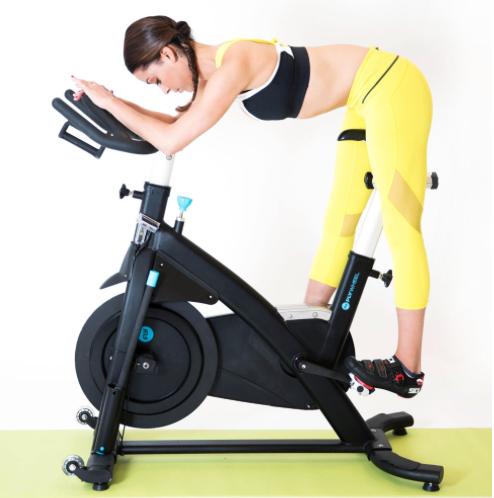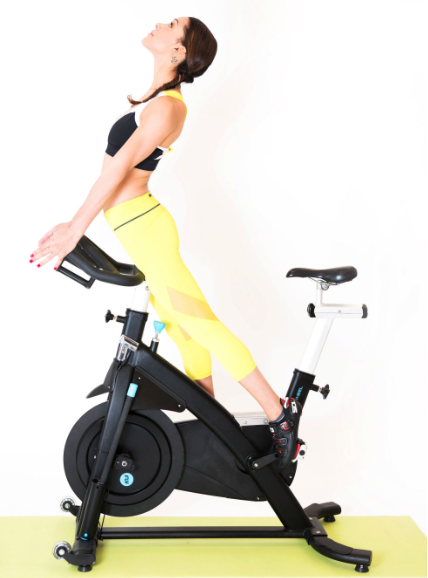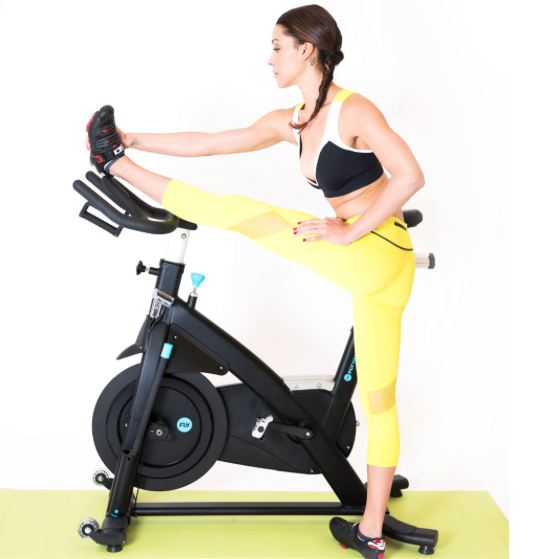I posted this on the ICA Facebook page the other day, as well as in one of the indoor cycling forums on Facebook, and it caused a firestorm. I’d love your thoughts on the subject of stretching on the bike in your indoor cycling or Spinning® class.
Cosmopolitan magazine posted this article on The Only 5 Stretches You Need To Do After Indoor Cycling.
I’ve been teaching Spinning since 1996, and have traveled around the world educating instructors as a master instructor for 18 years. I’ve always taught that you should never stretch while still on the bike (lower body, that is). Nor should you throw your foot over the handlebars to stretch the hamstrings. The risk of injury is just too high, especially when you have a large group who you can’t closely watch to ensure they are all clipped in.
I’ll start off by saying if you want to do these stretches on your own bike, when no one else is there, then no one is stopping you. You can smoke, drink, play with matches, not wear a seat belt (well, legally you can’t) all you want…the point is, you are the commander of your own risk. The idiocy is when you lead others in doing these stretches, and they follow you because they trust you for your knowledge to know what’s best for them. It’s especially irresponsible when there are stretches that are far more effective and less risky which can target the same muscles.
While I disagree with the first three stretches in this article, numbers 4 and 5 are perfectly fine (standing quad and hip stretches). Let’s take a look at the first three.
Pose #1, stretching the calves and back while on the bike.
The way she’s flexing forward isn’t dangerous in and of itself (unless she was leaning back…more on that in a moment), but when you put weight into the cranks with the pedals horizontal to the ground (at the 3 and 9 o’clock position), there is an awful lot of torque being applied to the cranks in opposing directions. Not so bad if it’s a 110 lb woman, but certainly very hard on your cranks if it’s a 200+ lb human. So if your riders don’t believe you that it’s not the best stretch for their calves, then tell them it’s not allowed because it’s hard on the cranks.
For your riders who do not have clipless pedals, they will struggle to get the same calf stretch as those who are clipped in. Newbies often do not tighten the toe straps enough, so you are leaving them out of this very beneficial stretch that you can so easily target standing up.
Shari Miranda, ICA editor, told a story on my Facebook post about how just that very morning, one of her riders who frequently disregarded her warnings about stretching on the bike was leaning way off the back of the bike during the stretch (like this pose but with arms straight, hips hanging off the back). Shari said there was a crash and a thud, and she saw this rider on the floor, still clipped in, with tears in her eyes. The handlebars had slid completely off the bike and she landed hard on her tailbone. The rider simply ignored the instructor’s cues, and either hadn’t tightened the handlebars or something had broken off. This stuff happens, guys! They are very lucky this rider wasn’t injured beyond her ego, and isn’t litigious.
Another instructor posted that she too had a rider who nearly fell off the back of the bike. Can you imagine if a rider fell off directly onto the handlebars or the flywheel of the bike behind? Why take this kind of risk when it’s so incredibly easy to avoid by choosing a safer stretch?
Pose #2, the Titanic.
This tops all the others in danger and absurdity. I call it the Titanic, after the figurehead sticking out from the bow of a ship. Someone else on one of the forums referred to this as upward dog on the handlebars. Or, one might say she’s humping the handlebars. Whatever you call it, it’s extremely risky, especially in a large group fitness class. As an avid cyclist, I have 30+ years experience clipping into clipless pedals. I know how they work; however, in my class just a few days ago, my shoe unclipped from the cleat. It’s not an uncommon thing to happen. Had I been doing a stretch like this, with my toes pointed down when that happened, I would likely have broken an ankle.
If you have been teaching cycling for long, you know that newbies don’t understand clipless pedals; they often think they are clipped in when they aren’t. Imagine your non-experienced rider doing this stretch—they are far more likely to come unclipped. Not to mention that a person heavier than the lithe woman in the photo could easily rip the cleats out of clipless pedals if the cleats are even slightly worn.
The pelvic area is really sensitive—for both men and women. Have you ever hit yourself there? Why would you put yourself in such a risky position?
As an experienced instructor, you probably know that handlebars aren’t always tightened down by your students. We have the FreeMotion bikes, and I’ve noticed riders don’t always tighten the fore/aft adjustment all the way. Do this upward dog against handlebars that aren’t sufficiently tightened…and you can see the disaster waiting to happen.
Years ago during the stretch after one of my classes (off the bike), we heard a loud bang. Someone’s handlebars slid completely down with a huge ruckus. She hadn’t secured the pop pin; somehow it had endured the whole class, but thankfully waited to fall until we were done. Talking to other instructors, I’ve heard similar stories, so it’s not uncommon. Can you even imagine if you were leaning out over the handlebars and this happened?
Stretch #3, putting the leg over the handlebar.
I’m pretty flexible; I can do this no problem, and some of my riders probably can as well. But many others cannot. People don’t like to be seen as not following what the instructor is doing, so even if someone is very inflexible, they will likely follow suit. They can very easily get knocked off balance, and can fall over sideways or backwards into another bike. That’s not just paranoia or hype…it’s a very likely scenario. In fact, two instructors commented in the forums this very thing had happened in their class or at their studio. One instructor said it led to a $3 million dollar law suit as a result of a participant getting seriously injured when she fell over doing a stretch like this.
You also have to ask, is it the best way to stretch the hamstrings by putting the foot up that high, even if you are flexible? No, you can get a deep an satisfying stretch by using the lower crossbar of the bike, holding your foot, and tipping your tailbone to the wall behind you to lengthen the hamstring. Try it…you’ll love it!
High risk = high liability!
Mark my words…if you are the one leading your class in stretches like these, and one of these above scenarios happens to one of your students, then you run the risk of being liable. And if not you, the instructor, they will go after the deeper pockets and sue the club or studio.
The danger to the individual is just too high, and the liability for instructors and studios is too high. Since I started ICA, I have gotten dozens of questions over the years about what to do about lawsuits. Don’t think they happen? Think again—they do! People will sue you if they hurt themselves doing these things YOU the instructor told them to do.
IT’S NOT WORTH IT! You could lose your studio, and your shirt while you’re at it. There are better, safer, and more effective ways to stretch off the bike.
Coming soon, I will write an article and post a few videos on the safest and most effective stretches following your cycling classes.
Please share this article far and wide. Every studio needs to know if their instructors are increasing their liability with foolhardy stretches (or other techniques on the bike, but that’s another article!).





Thanks Jennifer for a great article. Great info about bike integrity and differences between inside and outside bikes. In addition Instructors should also have a basic understanding on how the body works too. In that respect, stretching on the bike just makes no sense. The pedals are unstable, so you are relying on another part your body to stabilize yourself as you stretch. There is absolutely no reason to do that when there is a stable floor right there for support! The leg over the handle bars is ineffective for stretching the hamstrings as well….most people are just stretching and hunching their back more because of inflexible femur/pelvis /hamstring. Which make no sense if they’ve been hunched over their bike for an hour already. Instructors should start with the end in mind and understand what the goal is with the end of class stretch and how to accomplish that in the most effective and safe way.
I have been teaching for 19+ years, I was taught at first to do the calf stretch on the bike but I never really felt it was a good enough stretch for me. So, I eventually got into the habit of stretching the calfs on the base of the bike, OFF the bike. Also, with a facility that has many classes a week the wear and tear on the bikes are huge!! Several times a year I witness a pedal sheer off, plus the toe cage members are open to risk.
I for one found it very hard to get my leg up on the handle bars and have never taught the stretch that way. I agree with Jennifer that if you cue the member to parallel the hips and draw the tailbone back away from the bike they get a very significant hamstring stretch.
I have seen members try to get their leg up on the handle bars and not be able to get it off! I am lucky that I haven’t had anyone fall with the hamstring stretch but boy were they embarrassed!!
Aw man, I love the calf stretch on the bike but I can see how it’s opening yourself up to liability issues in a class setting. Guess we’ll be switching to off the bike calf stretching now. Thanks for the article.
I usually have the riders perform a gentle heel drop while on the bike for a calf stretch. Do you have a suggestion for an alternative calf stretch off the bike?
We have a very tight space and we come off the bike for the remaining stretches. For the hamstring I cue riders to find a height for their foot that is appropriate for their flexibility – that can be the floor, a saddle dropped all the way down, etc…
Stephen, how can an instructor adjust clips for every student before each class?
I agree some are very loose. When I’ve ever encountered that, we had them tightened. Some facilities may have no idea how to do that, which increases the risk of a rider’s foot coming out.
And sometimes the clips are fine, but the cleat is worn. that’s why mine came out..I was using an older pair of mtn bike shoes, not my regular ones. Riders may not realize that they can get worn down…but it’s probably not going to happen with indoor-only riders (well…unless they are obsessive!) 😉
“How can an instructor adjust clips for every student before each class?”
They can’t. That’s my subtle point.
What is recommended for a rider on THEIR road bike is not applicable to a general purpose indoor bike.
So you recommend not having clipless pedals? While there is the occasional issue mentioned in my article, the benefits far outweigh the disadvantages. (And any disadvantages can be minimized even further by not doing silly stuff on the bike!)
I really hate when I have to use toe clips!
No, I am not recommending not using clipless pedals. I am trying (and failing) to point out that what works (and is recommended) outside – stretching the calf muscles on the bike – is not suitable for doing inside on group cycle bikes.
I do have riders stand on the pedals at 3 and 9 and drop their heels for stretch on the bike. It is a stretch you do outside while riding and need to help out the calves. Not sure why it would be worse for the pedals than standing while spinning. I don’t do stretch 2, but do have riders look toward the ceiling while standing on the pedals. Would love to hear from a stationary bike company about the issue with standing on the pedals for a stretch.
I’ve been known to do that on my road bike outside too, but it’s only ever me riding my bike, and at the most, 3-5X a week (in cycling season that is…5-6 months a year it’s hanging in the garage until the snow clears), and I only weigh 138. Indoor bikes get a lot more wear and tear than a road bike will, in some places they are used day in/day out, many times a day. Also, as mentioned, if you get a really large frame on that bike weighing over 200 lbs pushing down in opposite directions, that’s a lot of torque. I’ve also seen numerous times riders bouncing while doing this stretch, which increases the torque. It was a bike manufacturer who told me how hard it is on the cranks, and requires changing more often than if it was not done. Bikes are expensive, so if there is a way to reduce the wear and tear, I would think studios would opt for that method.
What does looking towards the ceiling while standing on the pedals do? Can the same thing be done while off the bike? I sometimes have my riders reach to the ceiling (off the bike) and look up while pulling the arms back, a stretch that feels really good but doesn’t put them at risk.
Jennifer
I appreciate the concern for the bikes, but found standing on the pedals works well for a calf stretch. I am not suggesting pushing down hard, just standing and dropping the heels. Standing on the edge of a stair would also work, but riders are on the bikes already. Never thought about the torque on the pedals and I have never had a pedal break of or damaged. Looking toward the ceiling helps relieve the tension on the back of the neck that you sometimes get from riding the bike, just a bit of counter movement. Not sure if that is the proper term. The on-bike stretch may not be great inside, but it is recommended by several bike sites for outside riding.
http://www.cyclingweekly.co.uk/fitness/stretching-techniques-31329
http://triathlete-europe.competitor.com/2011/06/10/stretching-with-your-bike
Good food for thought.
At one gym, we had a pedal break years ago while I was riding it (and I don’t think the bikes were that old). I was extremely lucky not to have gotten injured.
As a Master Instructor for 18 years, I’ve heard many stories from instructors and studios around the world about pedals breaking. And in fact, this article just posted today about a pedal breaking, leading to a €15,000 judgement for the guy who was riding the bike and sustained a deep gash. http://www.independent.ie/irish-news/courts/man-29-awarded-15k-after-he-lacerates-leg-on-exercise-bike-during-spinning-class-31077623.html
So yeah…pedals do break.
I think that you need to look at your audience. Are they all using clipless pedals?
If they are, have the clips on the pedals been adjusted for their specific shoe/weight/ability?
I have been on indoor bikes that have the clips so loose that I might as well not use them – I would be more secure with the cage/strap combo on the other side.
When I first started teaching 8+ years ago, I had folks doing lower body stretching while on the bike. I stopped doing that after I saw someone slip out of a pedal while doing a calf stretch and land on the front of the saddle.
It was not a pretty picture …
thanks for sharing that Bob. That reminded me of an incident that I forgot about when I wrote that article; one that had the potential to be extremely serious. A rider comes into my class and gets on a bike. The previous user had raised the handlebars up to the very highest point, and it wasn’t tightened down. The new rider gets on, puts weight on one side of the handlebars and they come out. He pitches forward into the bike in front. You know the sharp end of the seat slider bar? Well that grazed his right temple, very close to his eye. If he had been a half inch closer, it could have taken out his eye.
He was very embarrassed. I made sure he was OK, and then ran to get management, who took care of him, bought him a hat, made him feel good. He even came back to ride the rest of my class 15 minutes later with a smile on his face!
Again…stretching on the bike in odd positions increases the likelihood of these types of injuries.